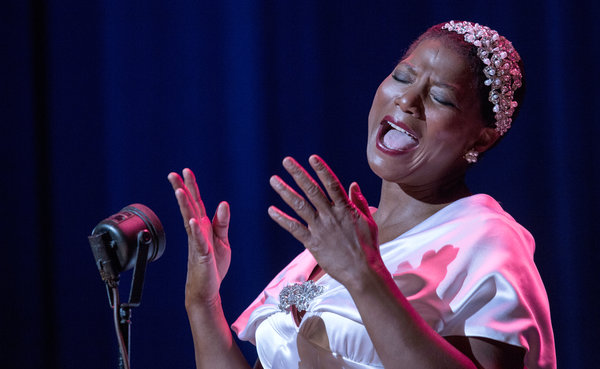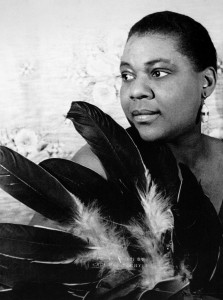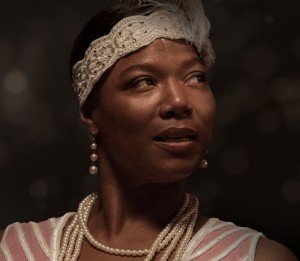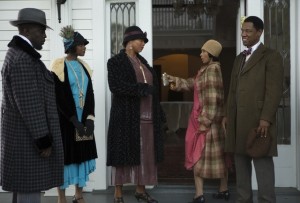
Oscar nominee Queen Latifah (Chicago) stars as legendary blues singer Bessie Smith in the HBO Films drama BESSIE, directed by filmmaker Dee Rees (Pariah) from a screenplay by Dee Rees and Christopher Cleveland & Bettina Gilois. With a story by Dee Rees and Horton Foote, the film focuses on Smith’s transformation from a struggling young singer into “The Empress of the Blues,” one of the most successful recording artists of the 1920s and an enduring icon today. Debuting SATURDAY, MAY 16 (8:00-10:00 p.m. ET/PT) on HBO, BESSIE is executive produced by Richard D. Zanuck, Lili Fini Zanuck, Queen Latifah, Shakim Compere, Shelby Stone and Randi Michel. Ron Schmidt produces.
HBO: How did you get involved in BESSIE?
QUEEN LATIFAH: It came to me through the Zanuck Company more than 20 years ago. I auditioned for the role at the time and I’ve been attached to it since then. It’s been a long time, but it was a story worth telling and a character worth sticking with. It’s been satisfying to finally see it happen. I’m looking forward to people finding out who Bessie Smith is if they don’t know about her already.
I didn’t know who Bessie was when this movie came to me in my early 20s. I did some homework and realized how influential she was and what amazing things she accomplished. For example, when you find out what an influence she was on Billie Holiday, it brings her importance into focus.
HBO: Bessie looks to Ma Rainey as a mother figure in the film.
QL: That was something that Dee Rees felt was important to reflect in the script. We’ve heard about some of the big barriers Bessie was able to break down. She was seen as this strong, fearless woman who could take a punch as well as give one, but Dee wanted to show her vulnerable side. Bessie really needed love and missed her mother, who died when she was young. Ma came into her life and filled that role. Mo’Nique and I had a great time showing that. It was a lot of fun playing those scenes with her, because there’s real-life affection between us, as well as onscreen with our characters.
HBO: Did you always see BESSIE as the story of a search for family?
QL: There are so many aspects of her life that could be told. You could do an entire series on her, not just a couple of hours. There’s a lot to tell. She lived a hell of a life, and did a lot in her short time on earth. Bessie was the type of person who would fight for someone else quicker than she’d fight for herself, and personally, I can relate to that. I’ve never like bullies, and as early as second grade I was sticking up for my classmates who were being bullied. But when I was bullied, I felt the same fear as everyone else. It’s not that Bessie wouldn’t stick up for herself because she damned sure would. She wasn’t always right. She was wrong as often as she was right, but that’s just the human condition. It was important for us to show that.
HBO: Bessie’s relationship with her husband, Jack (played by Michael K. Williams), exposed her vulnerable side.
QL: Bessie needed a man who would fight for her and protect her, and she saw that in him. Things didn’t always go smoothly between them, but I do think they loved each other.
HBO: Did you know Michael K. Williams before shooting BESSIE?
QL: We’ve known each other since we were teenagers, and we’ve watched each other go from being kids just hanging out to successful actors, but this was the first time we’ve worked together. It was a blast for us.
HBO: Your resume as an actor includes everything from comedy to drama to musicals. Were you able to draw on any of your previous roles in playing Bessie?
QL: I had to start from scratch. Bessie is her own character. I could have played this role at age 22, but I didn’t have the life experience I can bring to it now. I was exhausted, frankly, after a day’s work of being Bessie. She had a husband, a boyfriend and a girlfriend. She was fighting and singing. She’s a lot of woman, and I was more than happy to come home from work and take a nice hot shower and get some rest!
HBO: The blues scene of the ‘20s was an evolving scene, much like hip-hop in the ‘80s when you came along. Do you see parallels?
QL: Definite
ly. One of the things the blues was able to do was speak a language that white America didn’t understand, but black America surely did. Hip-hop did the same thing. We were able to express ourselves through the music and create our own culture and communicate what was going on in our world.
HBO: In singing Bessie’s songs, did you try to find a balance between your own style as a vocalist and hers? You obviously aren’t trying to imitate her.
QL: Absolutely. I tried to draw on her style in different ways, whether it’s her vibrato or the way she said certain words. Listening to Bessie as a musician is amazing because she does something I like to do, which is bounce around the tempos, go from 4/4 to thirds, then swing something and jump back. In one song she can go from gospel to jazz to straight blues. Bessie’s style was unlike anyone else’s. She was a real powerhouse and had a lot of grit in her voice. You could hear when she was partying really hard and when she wasn’t. I just tried to find enough similarities of what she does in my own voice. I wish she had lived long enough to go into jazz because she was headed that way. Bessie would have been one of the most incredible jazz singers ever to walk the face of the planet, because she was such a damn good singer.
HBO: How did you get involved with BESSIE? What drew you to this project?
DEE REES: I originally got involved with BESSIE as a writer in 2012. I still remember the e-mail from my agent asking whether I was interested – it was the fastest and shortest response I’ve ever sent – “Hell yeah.” I couldn’t believe that they were making a film about Bessie, and I knew that I had to be involved and that I wanted to tell this story. My grandmother talked about Bessie Smith and played her compilation albums when I was younger. Then there was this 1970s vaudeville tribute album called “One Mo’ Time” by Vernel Bagneris, which was a musical stage play and a big send-up to all the great black vaudevillians of the time – Butterbeans & Suzie, Ma Rainey, Bessie Smith – with skits and everything in between. My grandmother, my mom and I listened to that album over and over again. So I was drawn to this project by the memories of my mother and grandmother and the music I remember them playing for me. We’d be dancing around the den all evening, it’d be past my bedtime and I didn’t wanna go to bed. I’d put these long red knit dress socks over my hands as if they were evening gloves, and we’d be dancing around the room to “‘Tain’t Nobody’s Business If I Do.”
HBO: You gained critical acclaim for your award-winning indie film “Pariah.” How was that similar to working with HBO on BESSIE?
DR: BESSIE was similar to “Pariah” in that it was a character and a world that I was completely passionate about. Like Alike Freeman in “Pariah,” bringing Bessie Smith’s personality to life was about mining her core for the unspoken longings, fears and loves that she experienced and trying to “get behind her eyes” and understand her world view. Specifically, I was interested in the idea of how Bessie was perceived and the bold, impermeable persona that she put forth, but was not necessarily how she felt inside. I wanted the photography and the design palate to mirror Bessie’s emotional inner landscape and take the audience into the intimacy of her unexpressed feeling, not just the bravura that was reflected in her performances. With both BESSIE and “Pariah,” I was always trying to get the truth of who these women were and find some honesty in their intentions.
HBO: What challenges did this film present?
DR: I was working with a historical figure and the facts of her life, so I had to take care with that. I had to listen to and channel more of what Bessie was saying in between the lines of her work, versus projecting my own presumptions onto her character. Little visual record exists of her beyond publicity and promotional photos, not to mention the lack of live “moving” images of her. Even her live vocal performances were unrecorded, so all we have of her are anecdotes and the commercialized delivery of her lyrics as recorded by Columbia Studios. But we all know that even the recorded lyrics weren’t always what she sung live in tent shows, so the record we have of her is edited and censored in some ways. Trying to find Bessie’s voice in all that – her real voice, not her “performance voice,” or her “as-recounted-third-hand-by-other people” voice – was extremely challenging. I relied on Bessie’s lyrics from the songs that she herself wrote, using her own words, descriptions and feelings to try to construct her voice. I still had to allow my imagination to fill out the arc of her experiences and decide what she might have done or said in the context of certain relationships and the many gaps in between.
HBO: What type of research did you conduct for the film?
DR: I hit the public library – hard. I ordered more books from Amazon, I listened to Bessie’s music. In fact, the first place I started in getting to know her was to pull the lyrics from the songs that she herself wrote, not the songs that others wrote for her. In this way, I was able to glean some of Bessie’s personality and point of view from her response to the world around her. I think one of the best ways to know an artist is through their work.
HBO: What other resources helped inspire you in bringing BESSIE to life?
DR: In order to really appreciate the magnitude of what Bessie achieved, it was really important to contextualize her against the time in which she was operating. Angela Y. Davis’s text “Blues Legacies and Black Feminism” was essential to understanding that and was my core reference book. Bessie grew up in a Chattanooga, where the presence of ex-Union soldiers would have been felt. In entertainment, there would have been blackface performances – yes, black performers in blackface – and there would have been all the muddy, bloody confusion and cacophony of a country trying to rebuild itself. Despite the end of the Civil War and the emancipation of the slaves, the Black Codes essentially maintained the status quo, but the two new things that black people
did get a stronger hold on were geographic and sexual mobility. There was more freedom of movement and more freedom to choose one’s own sexual partner, all while the railroads were ripping great swaths of access and entry across a still-scarred country. So, in this kaleidoscopic landscape, a young Tennessee girl decides to be something else, to chart a completely new path.
At Bessie’s core, I also found this need for mother-love, this motherless child specter started to emerge; Jamaica Kincaid’s supreme work “The Autobiography of My Mother” was also elemental in helping me understand what that need might feel like. Kincaid’s brilliant prose and the tone of fragmented memory and lost love that her book imparts were pivotal for me and was the inspirational core around which I tried to reconstruct the flesh of Bessie’s character. Jamaica Kincaid opens her book with this gorgeous idea: “My mother died at the moment I was born, and so for my whole life there was nothing standing between myself and eternity; at my back was always a bleak, black wind. I could not have known at the beginning of my life that this would be so; I only came to know this in the middle of my life, just at the time when I was no longer young and realized that I had less of some of the things I used to have in abundance and more of some of the things I had scarcely had at all. And this realization of loss and gain made me look backward and forward: at my beginning was this woman whose face I had never seen, but at my end was nothing, no one between me and the black room of the world.”
HBO: What do you hope viewers will take away from the film? What will they learn from the music of that era?
DR: I’m hoping that viewers will take away the significance of the continuum of blues singers that shapes our musical palette today: the Ma Rainey-Bessie Smith-Billie Holiday connection, and the fact that they all come from the same line and that their work is in dialogue with each other as part of a vital artistic spectrum that shapes everything we listen to today. From Ma comes Bessie, from Bessie comes Billie, from Billie comes Nina Simone. This legacy of radical feminine consciousness and political activism is channeled through the voice. Voices speaking from the stage, from the phonograph, from the radio what could not be said in their daily lives. If Ma had not dared us to “prove it on her,” then perhaps Bessie could not have named her oppressor with “all my life I’ve been making it, all my life white folks have been taking it,” then Billie might not have sung about “Strange Fruit,” and then perhaps Nina could not have shouted “Mississippi Goddamn!” They are all in conversation with one another, each artist putting a finer point on it, each verse a sharper critique of our country’s systemic dysfunction and the distortion that supports it, each woman sharpening the sword with the whetstone of her voice, the sword that eventually plunged through the heart of white supremacy. Their work is part of a collective consciousness. It’s all linked together. Again, this is what Angela Y. Davis does so thoroughly and indisputably in “Blues Legacies and Black Feminism,” and I hope that will come through and that audiences will see the link to their present-day incarnations and better understand how these women’s artistic legacies defy musical genre and continue to echo implicitly in unrealized ways.
HBO: What was your favorite element in working on the film?
DR: Just working with actors, without a doubt. It’s one thing to write scenes alone over a keyboard and to imagine the actions and reactions in your head, but it’s a completely other thing to hear actors speaking your words, to see their bodies bringing the fullness of emotion, need, desire and pain to life right in front of you. It’s amazing. As a director, I coax, tease, cajole, insinuate, instigate – I really enjoy winding the actors up against each other and seeing what happens. They surprise me; they surprise themselves; they surprise each other. Something completely “other” happens and suddenly we’re all flying, transcending the script, the camera, the crew members standing around watching. Working with actors is the most fulfilling part of the process. I love them. I admire them. Their work is so brave and impossible. Committing your mind and body completely over to a thing, believing a thing, living a thing. Suddenly we’re all living and breathing and feeling together. It’s overwhelming. It’s nakedness. It’s magic. It’s risking. It’s collective. It’s creation. Nothing feels higher.
There you go. Let’s wrap this up by saying – if you are not watching HBO Films presentations like BESSIE you are missing out of some of the best cinematic gems out there. It may be an old simple tagline, but it says it all. Its not TV, its HBO! Enjoy now one of the presentations that will later be honored at awards time. HBO Films: BESSIE.


 ly. One of the things the blues was able to do was speak a language that white America didn’t understand, but black America surely did. Hip-hop did the same thing. We were able to express ourselves through the music and create our own culture and communicate what was going on in our world.
ly. One of the things the blues was able to do was speak a language that white America didn’t understand, but black America surely did. Hip-hop did the same thing. We were able to express ourselves through the music and create our own culture and communicate what was going on in our world.

 did get a stronger hold on were geographic and sexual mobility. There was more freedom of movement and more freedom to choose one’s own sexual partner, all while the railroads were ripping great swaths of access and entry across a still-scarred country. So, in this kaleidoscopic landscape, a young Tennessee girl decides to be something else, to chart a completely new path.
did get a stronger hold on were geographic and sexual mobility. There was more freedom of movement and more freedom to choose one’s own sexual partner, all while the railroads were ripping great swaths of access and entry across a still-scarred country. So, in this kaleidoscopic landscape, a young Tennessee girl decides to be something else, to chart a completely new path.